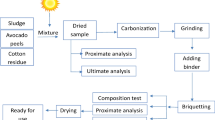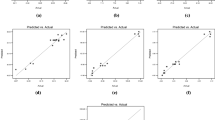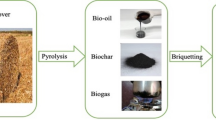Abstract
Multiple factors are responsible for the properties of developed briquettes. The effect of the agricultural residue type in determining resulting properties of developed briquettes is seldom elucidated. Agricultural residue biochars from groundnut shells, sugarcane bagasse, coffee husks, and rice husks were used in develo** carbonized briquettes using the low-cost compression method. In this study, a general factorial multi-level categorical experimental design method was used to investigate the effects and interactions of the carbonized agricultural type, binder type, and binder amount on physical properties and calorific values of developed briquettes. Statistically significant models (p < 0.05) were obtained for physical property responses of fixed carbon, ash content, volatile matter, and moisture content as well as calorific values for the developed briquettes. In experiments where only cassava starch binder (30 g and 50 g) was used, carbonized agricultural residues played a significant role in the resulting physical property. Increasing the cassava starch binder from 30 to 50 g had a minimal impact on the resulting briquette physical property. In experiments where cassava starch binder and wheat starch binder were used, it was clear that the physical property of the developed briquette was affected significantly by the carbonized agricultural residue used and binder type. Calorific values of groundnut shell and bagasse briquettes were observed to be significantly affected by the agricultural residue type. The highest calorific values of 23.9 MJ/kg and 23.3 MJ/kg were obtained for groundnut shell and bagasse biochar briquettes, respectively, when only 30 g of cassava starch binder was used. Changes in cassava and wheat starch binder amounts did not significantly affect heating values of developed groundnut shell and bagasse briquettes.











Similar content being viewed by others
References
IEA (International Energy Agency) (2019) World Energy Outlook 2019, IEA, Paris
IEA (International Energy Agency) (2019) Africa Energy Outlook 2019, IEA, Paris
Mwampamba TH, Owen M, Pigaht M (2013) Opportunities, challenges and way forward for the charcoal briquette industry in sub-Saharan Africa. Energy Sustain Dev 17:158–170. https://doi.org/10.1016/j.esd.2012.10.006
Lubwama M, Yiga VA (2017) Development of groundnut shell and bagasse briquettes as sustainable fuel sources for domestic cooking applications in Uganda. Renew Energy 111:532–542. https://doi.org/10.1016/j.renene.2017.04.041
Lubwama M, Yiga VA (2018) Characteristics of briquettes developed from rice and coffee husks for domestic cooking applications in Uganda. Renew Energy 118:43–55. https://doi.org/10.1016/j.renene.2017.11.003
Lubwama M, Yiga VA, Muhairwe F, Kihedu J (2020) Physical and combustion properties of agricultural residue bio-char bio-composite briquettes as sustainable domestic energy sources. Renew Energy 148:1002–1016. https://doi.org/10.1016/j.renene.2019.10.085
Yank A, Ngadi M, Kok R (2016) Physical properties of rice husk and bran briquettes under low pressure densification for rural applications. Biomass Bioenergy 84:22–30. https://doi.org/10.1016/j.biombioe.2015.09.015
Zhang G, Sun Y, Xu Y (2018) Review of briquette binders and briquetting mechanism. Renew Sust Energ Rev 82:477–487. https://doi.org/10.1016/j.rser.2017.09.072
Muazu RI, Stegemann JA (2015) Effects of operating variables of fuel briquettes from rice husks and corn cobs. Fuel Process Technol 133:137–145. https://doi.org/10.1016/j.fuproc.2015.01.022
Aransiola EF, Oyewusi TF, Osunbitan JA, Ogunjimi LAO (2019) Effect of binder type, binder concentration and compacting pressure on some physical properties of carbonized corncob briquette. Energy Rep 5:909–918. https://doi.org/10.1016/j.egyr.2019.07.011
Bazargan A, Rough SL, McKay G (2014) Compaction of palm kernel shell biochars for application as solid fuel. Biomass Bioenergy 70:489–497. https://doi.org/10.1016/j.biombioe.2014.08.015
Liu Z, Jiang Z, Cai Z, Fei B, Yu Y, Liu X (2013) Effects of carbonization conditions on properties of bamboo pellets. Renew Energy 51:1–6. https://doi.org/10.1016/j.renene.2012.07.034
Borowski G, Stepniewski W, Wojick-Oliveira K (2017) Effects of starch binder on charcoal briquettes. Int Agrophys 31:571–574. https://doi.org/10.1515/intag-2016-0077
Onchieku JM, Chikamai BN, Rao MS (2012) Optimum parameters for the formulation of charcoal briquettes using bagasse and clay as binder. Eur J Sustain Dev 1:477–492. https://doi.org/10.14207/ejsd.2012.v1n3p477
Garcia R, Gonzalex-Vazquez MP, Martin AJ, Pevida C, Rubiera F (2020) Pelletization of torrefied biomass with solid and liquid bio-additives. Renew Energy 151:175–183. https://doi.org/10.1016/j.renene.2019.11.004
Nwabue FI, Unah U, Itumoh EJ (2017) Production and characterization of smokeless bio-coal briquettes incorporating plastic waste materials. Environ Technol Innov 8:233–245. https://doi.org/10.1016/j.eti.2017.02.008
Davies RM, Davies OA (2013) Physical and combustion characteristics of briquettes made from water hyacinth and phytoplankton scum as binder. J Comb 549894:1–7. https://doi.org/10.1155/2013/549894
Carnaje NP, Talagon RB, Peralta JP, Shah K, Paz-Ferreiro J (2018) Development and characterization of charcoal briquettes from water hyacinth (Eichhornia crassipes)-molasses blend. PLoS One 13(11):e0207135. https://doi.org/10.1371/journal.pone.0207135
Tumutegyereize P, Mugenyi R, Ketlogetswe C, Gandure J (2016) A comparative performance analysis of carbonized briquettes and charcoal fuels in Kampala-urban, Uganda. Energy Sustain Dev 31:91–96. https://doi.org/10.1016/j.esd.2016.01.001
Kpalo SY, Zainuddin MF, Manaf LA, Roslan AM (2020) Production and characterization of hybrid briquettes from corncobs and oil palm trunk bark under low pressure densification technique. Sustainability 12(2468):1–16. https://doi.org/10.3390/su12062468
Khlifi S, Lajili M, Belghith S, Mezlini A, Tabet F, Jeguirim M (2020) Briquettes production from olive mill waste under optimal temperature and pressure conditions: physico-chemical and mechanical characterizations. Energies 13:1214. https://doi.org/10.3390/en13051214
Nino A, Arzola N, Araque O (2020) Experimental study on the mechanical properties of biomass briquettes from a mixture of rice husk and pine saw dust. Energies 13:1060. https://doi.org/10.3390/en13051060
Ndindeng SA, Mbassi JEG, Mbacham WF, Manful J, Graham-Acquaah S, Moreira J, Dossou J, Futakuchi K (2015) Quality optimization in briquettes made from rice milling by-products. Energy Sustain Dev 29:24–31. https://doi.org/10.1016/j.esd.2015.09.003
Francik S, Knapczyk A, Knapczyk A, Francik R (2020) Decision support system for the production of miscanthus and willow briquettes. Energies 13:1364. https://doi.org/10.3390/en13061364
Montgomery DC (2013) Design and analysis of experiments, 8th edn. Wiley
Madhawan A, Arora A, Das J, Sharma S, Kuila A, Sharma V (2019) Different types of thermochemical pre-treatment and optimization of enzymatic hydrolysis of groundnut shell. Waste Biomass Volariz 10:661–670. https://doi.org/10.1007/s12649-017-0083-y
Bolado-Rodríguez S, Toquero C, Martín-Juárez J, Travaini R, García-Encina PA (2016) Effect of thermal, acid, alkaline and alkaline-peroxide pretreatments on the biochemical methane potential and kinetics of the anaerobic digestion of wheat straw and sugarcane bagasse. Bioresour Technol 201:182–190. https://doi.org/10.1016/j.biortech.2015.11.047
Yiga VA, Lubwama M, Olupot PW (2019) Effect of alkaline surface modification and carbonization on biochemical properties of rice and coffee husks for use in briquettes and fiber-reinforced plastics. J Nat Fibers:1–10. https://doi.org/10.1080/15440478.2019.1642824
Sawadogo M, Tanoh ST, Sidibe S, Kpai N, Tankoano I (2018) Cleaner production in Burkina Faso: case study of fuel briquettes made from cashew industry waste. J Clean Prod 195:1047–1056. https://doi.org/10.1016/j.jclepro.2018.05.261
Vassilev SV, Baxter D, Vassileva CG (2013) An overview of the behavior of biomass during combustion: part 1: phase mineral transformations of organic and inorganic matter. Fuel 112:391–449. https://doi.org/10.1016/j.fuel.2013.05.043
Amaya A, Medero N, Tancredi N, Silva H, Deiana C (2007) Activated carbon briquettes from biomass materials. Bioresour Technol 98:1635–1641. https://doi.org/10.1016/j.biortech.2006.05.049
Anderson MJ, Whitcomb PJ (2007) DOE simplified: practical tools for effective experimentation, 2nd edn. CRC Press
Oladeji JT (2010) Fuel characterization of briquettes produced from corncob and rice husk residues. Pac J Sci Technol 11:101–106
Werther J, Saenger M, Hartge EU, Ogada T, Siagi Z (2001) Combustion of agricultural residues. Prog Energy Combust Sci 26:1–27. https://doi.org/10.1016/S0360-1285(99)00005-2
Gilvari H, de Jong W, Schott DL (2019) Quality parameters relevant for densification of bio-materials: measuring methods and affecting factors. Biomass Bioenergy 120:117–134. https://doi.org/10.1016/j.biombioe.2018.11.013
Zaidul ISM, Yamauchi H, Kim S, Hashimoto N, Noda T (2007) RVA study of mixtures of wheat flour and potato starches with different phosphorus content. Food Chem 102:1105–1111. https://doi.org/10.1016/j.foodchem.2006.06.056
Zhu F (2015) Composition, structure, physico-chemical properties and modification of cassava starch. Carbohydr Polym 122:456–480. https://doi.org/10.1016/j.carbpol.2014.10.063
Funding
This research was supported by funding from Yosevi Engineering Services Limited.
Author information
Authors and Affiliations
Contributions
Michael Lubwama and Vianney Andrew Yiga were responsible for execution of experiments. Michael Lubwama, Vianney Andrew Yiga, and Harriet Nalubega Lubwama were responsible for analysis of data, writing, and technical editing during the preparation of this manuscript.
Corresponding author
Additional information
Publisher’s Note
Springer Nature remains neutral with regard to jurisdictional claims in published maps and institutional affiliations.
Electronic supplementary material
ESM 1
(DOCX 35 kb)
Rights and permissions
About this article
Cite this article
Lubwama, M., Yiga, V.A. & Lubwama, H.N. Effects and interactions of the agricultural waste residues and binder type on physical properties and calorific values of carbonized briquettes. Biomass Conv. Bioref. 12, 4979–4999 (2022). https://doi.org/10.1007/s13399-020-01001-8
Received:
Revised:
Accepted:
Published:
Issue Date:
DOI: https://doi.org/10.1007/s13399-020-01001-8




